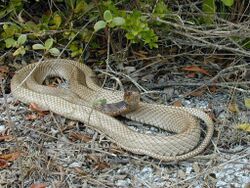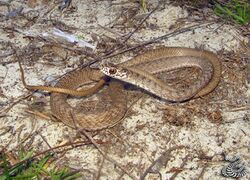Biology:Masticophis flagellum flagellum
| Masticophis flagellum flagellum | |
|---|---|

| |
| Eastern coachwhip Masticophis flagellum flagellum | |
| Scientific classification | |
| Domain: | Eukaryota |
| Kingdom: | Animalia |
| Phylum: | Chordata |
| Class: | Reptilia |
| Order: | Squamata |
| Suborder: | Serpentes |
| Family: | Colubridae |
| Genus: | Masticophis |
| Species: | |
| Subspecies: | M. f. flagellum
|
| Trinomial name | |
| Masticophis flagellum flagellum Shaw, 1802
| |
| Synonyms | |
Masticophis flagellum flagellum, commonly known as the Eastern coachwhip, is a subspecies of M. flagellum, a nonvenomous, colubrid snake, endemic to the southern United States .[5][6]
Distribution
The subspecies ranges from North Carolina to Florida in the east, and from eastern Kansas to eastern Texas in the west. They are notably absent from the Mississippi Delta, which divides their range into two separate groupings.[5]
Description
Adults are long and slender, ranging from 50 to 72 inches (130–180 cm) in total length. The longest on record was 102 inches (260 cm). They are among North America's largest native snakes. The head and neck are usually black, fading to tan posteriorly. Some specimens may lack the dark head and neck pigmentation.[5][6] Their smooth scales and coloration give the appearance of a braided whip, hence the common name.[6]
Habitat
The subspecies can be found in a wide variety of habitats, but is most abundant in the southeastern coastal plain. Its preferred habitat includes sandy pine woodlands, pine-palmetto flatwoods, cedar glades, and along creeks, marshes and swamplands.[5][6][7] M. flagellum adults and juveniles can be found in suburban neighborhoods where development encroaches on favorable habitats[8] A study done in southwestern Georgia found that the average home-range for the coachwhip is around 102.9 ± 28 ha.[9]
Behavior & diet
The Eastern coachwhip is an active, fast-moving snake. This colubrid snake can reach speeds up to 5.8 km/h with their streamlined body 4. It is diurnal and hunts it prey by smell and sight. It frequently hunts with its head raised above the ground and vegetation, and unlike most snakes, visually locks onto its prey's position before capture. Eastern coachwhips do not constrict their prey but will manipulate it to eat head first4. Following capture, the snake swallows its prey alive. It has strong jaws with rows of small, inward slanting teeth. It has sometimes been observed to beat its prey against the ground in an apparent effort to stun it prior to swallowing. Prey items include birds, large insects, lizards, other snakes, and small mammals.[6][7]
Reproduction
The breeding seasons spans from June through August, in which females produce one clutch of 4-24 eggs with an average of 11. Males reach sexual maturity at age 1 whereas females don't attain sexual maturity until age 3. Courtship behavior from males instigates copulation with a female, which can last up to 130 min. Mating system is polyandrous, meaning that although females will only produce one clutch of eggs, they will mate with multiple males over the breeding period. Males have been observed displaying territorial behavior in an attempt to prevent any further copulation from other males. The gestation period is around 77.5 days after which the female lays the eggs in a small animals burrow, no parental care is shown. [10]
Myth
A common myth is that the Eastern coachwhip will intentionally attack people and whip them with its tail. This is false.[5][11] In truth, when disturbed this snake will usually quickly flee. It will sometimes vibrate the tip of its tail among the ground litter, making a sound suggestive of a rattlesnake. If trapped, it will aggressively defend itself, striking repeatedly and biting.[6]
References
- ↑ Boulenger, G.A. 1893. Catalogue of the Snakes in the British Museum (Natural History). Volume I., Containing the Families...Colubridæ Aglyphæ, part. Trustees of the British Museum (Natural History). (Taylor and Francis, Printers.) London. xiii + 448 pp. + Plates I.- XXVIII. (Zamenis flagelliformis, pp. 389-390.)
- ↑ The Reptile Database. www.reptile-database.org.
- ↑ Conant, R. 1975. A Field Guide to Reptiles and Amphibians of Eastern and Central North America, Second Edition. Houghton Mifflin. Boston. 429 pp.
ISBN:0-395-19977-8 (paperback). (Masticophis flagellum flagellum, pp. 181-182 + Plate 26 + Map 141.) - ↑ Johnson, Richard W., et al. “Spatial Ecology of the Coachwhip, Masticophis Flagellum (Squamata: Colubridae), in Eastern Texas.” Southeastern Naturalist, vol. 6, no. 1, 2007, pp. 111–124., https://doi.org/10.1656/1528-7092(2007)6[111:seotcm]2.0.co;2.
- ↑ 5.0 5.1 5.2 5.3 5.4 "Eastern Coachwhip, Coachwhip, Racer". Florida Museum of Natural History. University of Florida. http://www.flmnh.ufl.edu/herpetology/fl-guide/masticophisfflagellum.htm. Retrieved June 1, 2012.
- ↑ 6.0 6.1 6.2 6.3 6.4 6.5 "Eastern Coachwhip". Outdoor Alabama. Alabama Department of Conservation and Natural Resources. http://www.dcnr.state.al.us/watchable-wildlife/what/Reptiles/Snakes/ec.cfm. Retrieved June 1, 2012.
- ↑ 7.0 7.1 "Eastern Coachwhip Species Profile". Reptile Channel.com. BowTie, Inc.. http://www.reptilechannel.com/reptile-species/snakes-profiles/eastern-coachwhip-2.aspx. Retrieved June 2, 2012.
- ↑ "Eastern Coachwhip" (in en-US). 2020-08-17. https://www.floridamuseum.ufl.edu/florida-snake-id/snake/eastern-coachwhip/.
- ↑ Jennifer M. Howze and Lora L. Smith "Spatial Ecology and Habitat Use of the Coachwhip in a Longleaf Pine Forest," Southeastern Naturalist 14(2), 342-350, (1 June 2015). https://doi.org/10.1656/058.014.0214
- ↑ Wilson, Larry (1968). The Coachwhip Snake, Masticophis Flagellum: Taxonomy and Distribution.
- ↑ "Eastern Coachwhip". Missouri Department of Conservation. Conservation Commission of Missouri. http://mdc.mo.gov/discover-nature/field-guide/eastern-coachwhip. Retrieved June 2, 2012.
Wikidata ☰ Q5403537 entry




